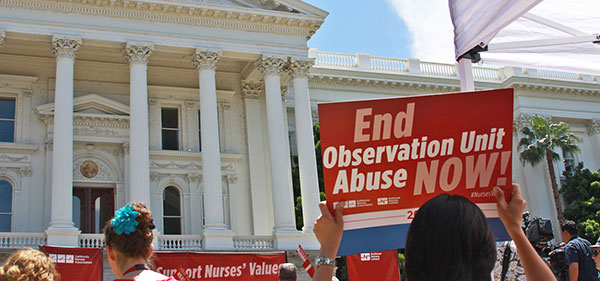Press Release
Huge Win for Patients – Gov. Brown Signs Bill to Protect Patients in ‘Observation’ Settings

In a huge victory for patients subject to lesser protections in some hospital settings, and economic sticker shock when then transferred to a nursing home, California Gov. Jerry Brown signed legislation Tuesday afternoon to substantially reform the use of “observation status” by California hospitals.
SB 1076, introduced by Sen. Ed Hernandez of West Covina on behalf of the California Nurses Association/National Nurses United, extends to patients placed in “observation” beds in hospitals the same safeguards, including safer nurse staffing, provided to other hospital patients.
“This is a great day for California patients. We’ve seen ‘observation’ patients held on gurneys in hallways or even placed in what they think is a regular hospital bed, without the same protections available to other patients, and without even being told they are subject to a lesser standard,” said CNA co-president Malinda Markowitz, RN
“Then to add economic injury to the pain of hospitalization, they can get hit with a massive extra costs, both in the hospital and when transferred to a nursing home to complete their recovery. Our thanks to Gov. Brown and to Sen. Hernandez for taking a major step forward to protect California patients,” Markowitz said.
“All too often, patients are kept overnight in the hospital without ever being admitted," said Senator Hernandez. “Now that Governor Brown signed SB 1076 into law, patients will be notified if they are on observation status, which may affect their insurance coverage.”
“Additionally, this will ensure that patients who are in observation care get the same level of nurse staffing as any other patient in the hospital,” Hernandez added. “I thank the sponsors, supporters and staff who worked tirelessly to ensure the passage of this essential piece of legislation."
Both nationally and in California the number of Medicare patients held in observation status by hospitals has doubled the past decade, noted Susan Jaffe in an article for Kaiser Health News last month. In California, the number of patients warehoused in observation has risen far faster than the percentage actually admitted to the hospital. http://californiahealthline.org/news/protecting-californias-seniors-from-surprise-hospital-nursing-home-bills/
While under “observation” status, the patient is only covered by outpatient regulations, allowing the hospital to avoid stronger regulatory standards for admitted patients, including California’s first in the nation law requiring a minimum number of nurses for hospitalized patients.
In addition to lesser hospital protections, observation patients can be slammed with enormous out of pocket costs, beginning in the hospital where they will be required to pay a much larger share of the bill for medications, treatment and tests.
Further, Medicare requires patients to be admitted as inpatients for three days before coverage for long-term care will kick in. Time spent in observation does not count, as observation services are outpatient services. Patients held in “observation” in a hospital are typically not even informed of their hospital status.
Jaffe cited the example of Lois Frarie, a 96-year old retired Monterey teacher hospitalized after a fall fractured her pelvis and elbow. After she was transferred to a nursing home to complete recovery, her family was hit with a $19,000 bill because she had, without her knowledge, been held in observation status in the hospital; ultimately all that was reimbursed was an ambulance ride.
SB 1076 goes into effect on January 1, 2017. It:
- Clarifies that observation units must meet the same staffing standards as emergency rooms.
- Requires hospitals to provide notice to patients that observation services are “outpatient” services and third-party reimbursement may be impacted – and to mark units dedicated for “observation” status as an outpatient area when that unit is not in an ER or part of a normal inpatient unit.
- Directs hospitals to report observation services to the Office of Statewide Health Planning and Development.
- Prohibits hospitals from evading the requirements by disguising “observation” units with a different name.